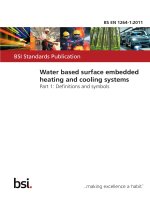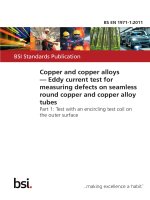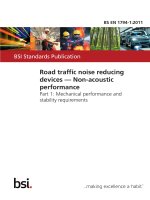Bsi bs en 61988 1 2011
Bạn đang xem bản rút gọn của tài liệu. Xem và tải ngay bản đầy đủ của tài liệu tại đây (1.61 MB, 58 trang )
BS EN 61988-1:2011
BSI Standards Publication
Plasma display panels
Part 1: Terminology and letter symbols
BS EN 61988-1:2011
BRITISH STANDARD
National foreword
This British Standard is the UK implementation of EN 61988-1:2011. It is
identical to IEC 61988-1:2011. It supersedes BS EN 61988-1:2003 which is
withdrawn.
The UK participation in its preparation was entrusted to Technical
Committee EPL/47, Semiconductors.
A list of organizations represented on this committee can be obtained
on request to its secretary.
This publication does not purport to include all the necessary provisions
of a contract. Users are responsible for its correct application.
© BSI 2011
ISBN 978 0 580 65878 5
ICS 31.260
Compliance with a British Standard cannot confer immunity from
legal obligations.
This British Standard was published under the authority of the
Standards Policy and Strategy Committee on 31 October 2011.
Amendments issued since publication
Date
Text affected
BS EN 61988-1:2011
EUROPEAN STANDARD
EN 61988-1
NORME EUROPÉENNE
EUROPÄISCHE NORM
September 2011
ICS 31.260
Supersedes EN 61988-1:2003
English version
Plasma display panels Part 1: Terminology and letter symbols
(IEC 61988-1:2011)
Panneaux d'affichage à plasma Partie 1: Terminologie et symboles
littéraux
(CEI 61988-1:2011)
Plasmabildschirme Teil 1: Terminologie und
Buchstabensymbole
(IEC 61988-1:2011)
This European Standard was approved by CENELEC on 2011-08-30. CENELEC members are bound to comply
with the CEN/CENELEC Internal Regulations which stipulate the conditions for giving this European Standard
the status of a national standard without any alteration.
Up-to-date lists and bibliographical references concerning such national standards may be obtained on
application to the Central Secretariat or to any CENELEC member.
This European Standard exists in three official versions (English, French, German). A version in any other
language made by translation under the responsibility of a CENELEC member into its own language and notified
to the Central Secretariat has the same status as the official versions.
CENELEC members are the national electrotechnical committees of Austria, Belgium, Bulgaria, Croatia, Cyprus,
the Czech Republic, Denmark, Estonia, Finland, France, Germany, Greece, Hungary, Iceland, Ireland, Italy,
Latvia, Lithuania, Luxembourg, Malta, the Netherlands, Norway, Poland, Portugal, Romania, Slovakia, Slovenia,
Spain, Sweden, Switzerland and the United Kingdom.
CENELEC
European Committee for Electrotechnical Standardization
Comité Européen de Normalisation Electrotechnique
Europäisches Komitee für Elektrotechnische Normung
Management Centre: Avenue Marnix 17, B - 1000 Brussels
© 2011 CENELEC -
All rights of exploitation in any form and by any means reserved worldwide for CENELEC members.
Ref. No. EN 61988-1:2011 E
BS EN 61988-1:2011
EN 61988-1:2011
-2-
Foreword
The text of document 110/236/CDV, future edition 2 of IEC 61988-1, prepared by IEC/TC 110, Flat panel
display devices, was submitted to the IEC-CENELEC parallel vote and approved by CENELEC as
EN 61988-1:2011.
This document supersedes EN 61988-1:2003.
EN 61988-1:2011 includes the following significant technical changes with respect to EN 61988-1:2003:
– Additional terms were added in Clause 3.
The following dates are fixed:
– latest date by which the document has to be implemented at
national level by publication of an identical national
standard or by endorsement
– latest date by which the national standards conflicting with the
document have to be withdrawn
(dop)
2012-05-30
(dow)
2014-08-30
Attention is drawn to the possibility that some of the elements of this document may be the subject of
patent rights. CENELEC [and/or CEN] shall not be held responsible for identifying any or all such patent
rights.
__________
Endorsement notice
The text of the International Standard IEC 61988-1:2011 was approved by CENELEC as a European
Standard without any modification.
__________
BS EN 61988-1:2011
-3-
EN 61988-1:2011
Annex ZA
(normative)
Normative references to international publications
with their corresponding European publications
The following referenced documents are indispensable for the application of this document. For dated
references, only the edition cited applies. For undated references, the latest edition of the referenced
document (including any amendments) applies.
NOTE When an international publication has been modified by common modifications, indicated by (mod), the relevant EN/HD
applies.
Publication
IEC 61988-2-1
1)
At draft stage.
Year
201X
1)
Title
EN/HD
Year
Plasma display panels Part 2-1: Measuring methods - Optical and
optoelectrical
EN 61988-2-1
201X
1)
BS EN 61988-1:2011
–2–
61988-1 IEC:2011
CONTENTS
FOREWORD ........................................................................................................................... 3
1
Scope ............................................................................................................................... 5
2
Normative references ....................................................................................................... 5
3
Terms and definitions ....................................................................................................... 5
4
Symbols ......................................................................................................................... 31
4.1
4.2
4.3
Annex A
General ................................................................................................................. 31
Symbol list by term name ...................................................................................... 31
Symbol list by symbol ............................................................................................ 33
(informative) Description of the technology ............................................................ 35
Annex B (informative) Relationship between voltage terms and discharge
characteristics ...................................................................................................................... 46
Annex C (informative) Gaps ................................................................................................. 47
Annex D (informative) Manufacturing ................................................................................... 48
Annex E (informative) Interconnect pad ............................................................................... 51
Bibliography .......................................................................................................................... 52
Figure A.1 – Principal structures and discharge characteristics of a DC PDP cell and
an AC PDP cell ..................................................................................................................... 35
Figure A.2 – Discharge characteristics of a cell (single cell static characteristics) ................ 37
Figure A.3 – Static characteristics of cells in a panel or a group of cells ............................... 38
Figure A.4 – Write waveform components ............................................................................. 39
Figure A.5 – Operation of a two-electrode type AC PDP ....................................................... 40
Figure A.6 – Relation between margins and applied voltages ................................................ 41
Figure A.7 – Structure of a three-electrode type, surface discharge colour AC PDP .............. 42
Figure A.8 – Address-, display-period separation method ..................................................... 43
Figure A.9 – A driving waveform for ADS method applied to a three-electrode ...................... 44
Figure A.10 – Address while display method ......................................................................... 45
Figure C.1 – Gaps (sustain gap, plate gap and interpixel gap) in a three-electrode type
AC PDP ................................................................................................................................ 47
Figure D.1 – PDP manufacturing flow chart ........................................................................... 49
Figure E.1 – Interconnect pad group ..................................................................................... 51
Figure E.2 – Dimensions of interconnect pads ...................................................................... 51
Table B.1 – Relation between static, dynamic and operating discharge characteristics
in a cell, a panel or a group of cells ...................................................................................... 46
BS EN 61988-1:2011
61988-1 IEC:2011
–3–
INTERNATIONAL ELECTROTECHNICAL COMMISSION
_____________
PLASMA DISPLAY PANELS –
Part 1: Terminology and letter symbols
FOREWORD
1) The International Electrotechnical Commission (IEC) is a worldwide organization for standardization comprising
all national electrotechnical committees (IEC National Committees). The object of IEC is to promote
international co-operation on all questions concerning standardization in the electrical and electronic fields. To
this end and in addition to other activities, IEC publishes International Standards, Technical Specifications,
Technical Reports, Publicly Available Specifications (PAS) and Guides (hereafter referred to as “IEC
Publication(s)”). Their preparation is entrusted to technical committees; any IEC National Committee interested
in the subject dealt with may participate in this preparatory work. International, governmental and nongovernmental organizations liaising with the IEC also participate in this preparation. IEC collaborates closely
with the International Organization for Standardization (ISO) in accordance with conditions determined by
agreement between the two organizations.
2) The formal decisions or agreements of IEC on technical matters express, as nearly as possible, an international
consensus of opinion on the relevant subjects since each technical committee has representation from all
interested IEC National Committees.
3) IEC Publications have the form of recommendations for international use and are accepted by IEC National
Committees in that sense. While all reasonable efforts are made to ensure that the technical content of IEC
Publications is accurate, IEC cannot be held responsible for the way in which they are used or for any
misinterpretation by any end user.
4) In order to promote international uniformity, IEC National Committees undertake to apply IEC Publications
transparently to the maximum extent possible in their national and regional publications. Any divergence
between any IEC Publication and the corresponding national or regional publication shall be clearly indicated in
the latter.
5) IEC itself does not provide any attestation of conformity. Independent certification bodies provide conformity
assessment services and, in some areas, access to IEC marks of conformity. IEC is not responsible for any
services carried out by independent certification bodies.
6) All users should ensure that they have the latest edition of this publication.
7) No liability shall attach to IEC or its directors, employees, servants or agents including individual experts and
members of its technical committees and IEC National Committees for any personal injury, property damage or
other damage of any nature whatsoever, whether direct or indirect, or for costs (including legal fees) and
expenses arising out of the publication, use of, or reliance upon, this IEC Publication or any other IEC
Publications.
8) Attention is drawn to the Normative references cited in this publication. Use of the referenced publications is
indispensable for the correct application of this publication.
9) Attention is drawn to the possibility that some of the elements of this IEC Publication may be the subject of
patent rights. IEC shall not be held responsible for identifying any or all such patent rights.
International Standard IEC 61988-1 has been prepared by IEC technical committee 110: Flat
panel display devices.
This second edition cancels and replaces the first edition published in 2003, and constitutes a
technical revision. The main technical changes with regard to the previous edition are as
follows:
–
Additional terms were added in Clause 3.
The text of this standard is based on the following documents:
CDV
Report on voting
110/236/CDV
110/286/RVC
Full information on the voting for the approval on this standard can be found in the report on
voting indicated in the above table.
BS EN 61988-1:2011
–4–
61988-1 IEC:2011
This publication has been drafted in accordance with the ISO/IEC Directives, Part 2.
A list of all the parts in the IEC 61988 series, under the general title Plasma display panels,
can be found on the IEC website.
The committee has decided that the contents of this publication will remain unchanged until
the stability date indicated on the IEC web site under "" in the data
related to the specific publication. At this date, the publication will be
•
•
•
•
reconfirmed,
withdrawn,
replaced by a revised edition, or
amended.
BS EN 61988-1:2011
61988-1 IEC:2011
–5–
PLASMA DISPLAY PANELS –
Part 1: Terminology and letter symbols
1
Scope
This part of IEC 61988 gives the preferred terms, their definitions and symbols for colour
AC plasma display panels (AC PDP); with the object of using the same terminology when
publications are prepared in different countries. Guidance on the technology is provided
in the annexes.
2
Normative references
The following referenced documents are indispensable for the application of this document.
For dated references, only the edition cited applies. For undated references, the latest edition
of the referenced document (including any amendments) applies.
IEC 61988-2-1:–, Plasma display panels – Part 2-1: Measuring methods – Optical and
optoelectrical 1
3
Terms and definitions
For the purposes of this document, the following terms and definitions apply.
3.1
AC PDP
NOTE
See AC plasma display panel.
3.2
AC plasma display panel
AC PDP
plasma display panel in which the gas discharge region is insulated from the electrodes that
are driven with AC voltage pulses
3.3
address bias
Vba
data bias
common voltage applied to all address electrodes during addressing
3.4
address cycle period
time interval between initiation of the closest spaced successive address pulses
3.5
address discharge
discharge that changes the state of a PDP subpixel
———————
1
Second edition, to be published.
BS EN 61988-1:2011
–6–
61988-1 IEC:2011
3.6
address electrode
data electrode
electrode, orthogonal to the scan electrode, that is used in driving the subpixels with
the image data
3.7
address period
time interval including the reset step and the address step
3.8
address pulse
data pulse
incremental voltage pulse applied to a single address (data) electrode for addressing,
to select a subpixel according to an image to be displayed
NOTE
See scan pulse.
3.9
address step
time interval needed to address all pixels in the panel in a given subfield as applied to the
ADS method
3.10
address voltage
Va
data voltage
amplitude of the voltage pulses applied to the address (data) electrode during addressing
(excludes the address bias on the electrode)
3.11
address while display method
AWD method
grey scale drive technique that addresses only a portion of the pixels of the panel in any time
within a sustain period
NOTE
See also ADS.
3.12
addressability
number of pixels in the horizontal and vertical directions, that can have their luminance
changed
NOTE Usually expressed as the number of horizontal pixels by the number of vertical pixels. This term is not
synonymous with resolution. See resolution.
3.13
addressing
setting or changing the state of a subpixel with an address pulse
3.14
ADS method
address, display-period separation method
grey scale drive technique that consists of addressing all the pixels in the panel in one time
period and sustaining all the pixels in the panel in a separate time period
3.15
ageing
manufacturing process consisting of operating the panel under conditions that stabilize its
performance
BS EN 61988-1:2011
61988-1 IEC:2011
–7–
3.16
annealing
process of heating the glass above its annealing point and cooling at a controlled rate
to minimize dimensional changes during subsequent high temperature cycles
3.17
anode
positively charged surface of a device that collects electrons from the discharge
NOTE
In an AC PDP, the cathode and anode exchange their roles on alternate half-cycles.
3.18
APL
average picture level
time average of a video signal during the active scanning time integrated over a frame period,
which is expressed as a percentage of the full white signal level while designating 0 % as the
black signal level
NOTE
There are two types of APL. See pre-gamma APL and post-gamma APL.
3.19
aspect ratio
ratio of screen width to screen height
3.20
auto power control
APC
circuit means to control the peak and/or average power of the display
3.21
auxiliary anode
anode in a DC PDP whose discharge contributes to supply priming particles to ignite a
discharge in a cell
3.22
back plate
rear plate
plate furthest from the viewer
3.23
back-filling
NOTE
See filling.
3.24
bake
NOTE
See bakeout and baking.
3.25
bakeout
high temperature processing of a vacuum system and/or PDP to assist in achieving low
pressures
3.26
baking
high temperature process used to evaporate water and decompose organic materials
NOTE
Baking is used to clean the parts by dispersing unwanted material into the atmosphere.
BS EN 61988-1:2011
–8–
61988-1 IEC:2011
3.27
barrier rib
rib that separates the cells of the panel, electrically, optically and physically
NOTE The barrier ribs may extend from the front plate to the back plate and control the spacing between
the plates.
3.28
binder burnout
process during which organic binders are remove by decomposition and/or oxidation
3.29
black level luminance
luminance of the panel in its minimum luminance state in a dark ambient
NOTE
See 6.3.3.3 of IEC 61988-2-1:– (Ed. 2).
3.30
black matrix
black material placed in the space between subpixel areas in order to improve contrast by
reducing reflectivity
3.31
black stripe
black material placed in the space between subpixel areas in order to improve contrast by
reducing reflectivity, having the form of stripes
NOTE
Black stripe is a specific type of black matrix contrast enhancement.
3.32
black uniformity, sampled
uniformity of the black level luminance expressed in terms of the percentage non-uniformity
(difference in luminance between measuring points divided by the average black level
luminance) at the specified measuring points
3.33
BRCR-#/#
NOTE
See bright room contrast ratio #/#.
3.34
breakdown voltage
smallest voltage between the cathode and the anode causing a gas discharge to grow to a
breakdown condition
3.35
bright defect
defect in the image reproduction that appears brighter than the correct image
3.36
bright room contrast ratio #/#
BRCR-#/#
contrast ratio with ambient illumination on the screen other than the nominal 100/70 levels
NOTE The symbol #/# describes the ambient illumination on the vertical plane/horizontal plane (see 6.4 of
IEC 61988-2-1:– (Ed. 2)).
BS EN 61988-1:2011
61988-1 IEC:2011
–9–
3.37
bright room contrast ratio 100/70
BRCR-100/70
contrast ratio with an ambient illumination on the screen of 100 lx on the vertical plane and
70 lx on the horizontal plane
NOTE
See 6.4 of IEC 61988-2-1:– (Ed. 2).
3.38
brightness
visual and subjective quality of how bright an object appears, or how much visible light is
coming off the object being perceived by the eye
NOTE
See luminance.
3.39
bulk erase
NOTE
See full-screen erase.
3.40
bulk write
NOTE
See full-screen write.
3.41
burn-in
process of increasing the reliability performance of hardware employing functional operation
of every item in a prescribed environment with successive corrective maintenance at every
failure during the early failure period
3.42
bus electrode
high conductivity electrode intimately connected along its length to the transparent electrode
in order to reduce total resistance
3.43
cathode
negatively charged surface of a device that emits secondary electrons to the discharge
NOTE
In an AC PDP, the cathode and anode exchange their roles on alternate half-cycles.
3.44
cell
physical structure of a subpixel or a subpixel itself (adjective – referring to the characteristics
of a single cell)
3.45
cell defect
cell showing a dark defect or a bright defect, or an unstable cell
3.46
cell pitch
subpixel pitch
3.47
cell voltage
Vc
time-dependent voltage across the gas in a plasma display cell
BS EN 61988-1:2011
– 10 –
61988-1 IEC:2011
3.48
centre firing voltage
average of the first-on voltage and the last-on voltage
3.49
centre minimum sustain voltage
average of the first-off voltage and the last-off voltage
3.50
chromatic uniformity
uniformity of the chromaticity produced by different areas of the screen
3.51
closed rib
rib structure which has walls on all sides of the cell
NOTE Examples are box type, mesh type, waffle type, hexagonal type, honeycomb type, etc. It is permissible to
have different rib heights on each side.
3.52
column electrode
address electrode
NOTE The column electrode was historically continuous in the vertical direction. When the panel is oriented in
portrait orientation, the column electrode can be aligned horizontally. See row electrode.
3.53
contrast ratio
ratio of white luminance to black luminance of the image, including light reflected from the
display
NOTE This ratio is strongly dependent on the ambient light and two forms are reported, bright room contrast ratio
( BRCR ) and dark room contrast ratio ( DRCR ). See 6.3 and 6.4 of IEC 61988-2-1:–, Ed. 2.
3.54
contrast ratio, sampled
CR
ratio of a white luminance to a black luminance at the specified measuring points
NOTE
See 6.3 and 6.4 of IEC 61988-2-1:– (Ed. 2).
3.55
coplanar PDP
NOTE
See surface discharge PDP.
3.56
crosstalk
phenomenon initiated by a discharge in one cell that causes an unwanted discharge in
a neighbouring cell
3.57
dark defect
defect in the image reproduction that appears less bright than the correct image
3.58
dark room contrast ratio
DRCR
contrast ratio measured in a dark room ambient, typically less than 1 lx
NOTE
See 6.3 of IEC 61988-2-1:– (Ed. 2).
BS EN 61988-1:2011
61988-1 IEC:2011
– 11 –
3.59
data bias
NOTE
See address bias.
3.60
data electrode
NOTE
See address electrode.
3.61
data pulse
NOTE
See address pulse.
3.62
data voltage
NOTE
See address voltage.
3.63
DC PDP
NOTE
See DC plasma display panel.
3.64
DC plasma display panel
DC PDP
plasma display panel in which the conductive electrodes are directly in contact with the gas
discharge
3.65
dielectric layer
layer or layers of non-conductive material that cover the electrodes, on which charges are
accumulated from the discharge
NOTE
The accumulated charge allows the memory function in AC PDPs.
3.66
dielectric voltage
Vd
voltage across a dielectric layer due to the wall charge that usually varies with time
Vd = Qw/Cd
where Qw is the wall charge and Cd is the effective dielectric layer capacitance
NOTE Charges other than wall charges may also appear on the dielectric surfaces, so that the total voltage
across a dielectric can be greater than its dielectric voltage.
3.67
diffuse reflection
diffusion by reflection in which, on the macroscopic scale, there is no regular reflection
3.68
direct laminated filter
front optical filter attached directly to the front of the panel
3.69
discharge current
component of current of a gas discharge resulting from the flow of electrons and ions in the
gas
BS EN 61988-1:2011
– 12 –
61988-1 IEC:2011
3.70
discharge delay time
formative delay plus statistical delay
NOTE When applying the addressing waveform, the peak of the discharge in an AC PDP generally occurs after
the statistical delay plus the formative delay.
3.71
displacement current
current flowing through the capacitance of a plasma display panel resulting from the changing
voltage applied to the electrodes
NOTE
Does not include the discharge current.
3.72
display anode
anode electrode of a DC PDP that is driven with positive DC voltage for the display discharge
3.73
display diagonal
screen diagonal
diagonal dimension of the addressable screen area
3.74
display electrode
scan and/or sustain electrodes in a three-electrode type PDP that provide the principal power
for the plasma discharge
3.75
display period
time interval of a subfield other than the address period where all of the sustain pulses in a
given subfield are applied to the panel
NOTE
This term is only used for the ADS method.
3.76
driving waveform
time-dependent voltage of a driving signal
3.77
drying process
manufacturing process that removes water and other volatile materials from the PDP subassemblies
NOTE
This often involves heating in an oven.
3.78
dynamic false contour
phenomenon wherein moving images create false contours
3.79
dynamic margin
margin that remains when addressing is active
NOTE
This term can be applied to various margins such as sustain margin or write margin, etc.
3.80
dynamic sustain range
sustain voltage range that allows proper addressing of all pixels over the entire range of write
voltage
BS EN 61988-1:2011
61988-1 IEC:2011
– 13 –
3.81
efficacy
NOTE
See luminous efficacy.
3.82
energy recovery circuit
circuitry that recaptures the reactive power of the plasma display panel capacitance by means
of an inductance
3.83
erase
operation that generates a discharge, generally between the address and scan electrodes, to
set subpixels to an off state
3.84
erase margin
ΔVer
erase voltage range that allows proper addressing of all pixels at the specified operating
conditions
3.85
erase pulse
voltage waveform applied to an electrode pair to selectively change the state of a subpixel
from on to off
3.86
erase voltage
Ver
voltage of the erase waveform applied between the electrode pair that receives the erase
pulse
3.87
erase waveform
time-dependent voltage signal applied to an electrode pair to selectively change the state of a
subpixel from on to off
NOTE
The erase wave form includes the address bias, the scan bias, the address pulse and the scan pulse.
3.88
evacuating
manufacturing process of removing the atmospheric gases by a vacuum process
3.89
exhaust tube
exhaust tubulation
exhaust pipe
tubular port in the device envelope that is connected to an external vacuum pump to evacuate
the air from the device during processing
NOTE
This is typically a glass tube that can be closed after filling with the appropriate gas by melting.
3.90
exoemission
delayed spontaneous emission of electrons from the cathode due to earlier excitation by the
gas discharge particles such as electrons, ions and ultraviolet photons
NOTE Exoemission from the cathode surface such as MgO typically decays slowly after the excitation event and
can continue at low current levels for times as long as seconds, minutes or even hours. The exoemission current
also usually depends on the temperature of the cathode and the amount of initial gas discharge excitation.
BS EN 61988-1:2011
– 14 –
61988-1 IEC:2011
Exoemission is very important for priming addressing discharges and it frequently has a major impact on the
maximum reliable addressing rate.
3.91
field
time interval during which a subset of all of the pixels is addressed and sustained at the full
range of grey levels
NOTE
See subfield.
EXAMPLE: In the case of an interlaced display, half of the pixels are addressed during the odd field and the other
half are addressed during the even field.
3.92
filling
process of filling the panel with gas after evacuating all of the air
3.93
firing
high temperature manufacturing process where various materials mixed with glass frit are
heated to make electrodes, barrier ribs or dielectric layers, etc.
NOTE
The heating is used to sinter the glass frit.
3.94
firing voltage
Vf
smallest sustain voltage at which a sustain discharge sequence spontaneously starts in a cell
NOTE
Not to be confused with the breakdown voltage. Typically, cells have slightly different firing voltages.
3.95
firing voltage range
∆Vf
range of sustain voltages between the first-on voltage and the last-on voltage or the
difference in voltage between the two
3.96
first-off
cell which turns off at the largest sustain voltage as the sustain voltage is decreased
NOTE
Defective cells are ignored.
3.97
first-off voltage
Vsm n
sustain voltage for first-off
3.98
first-on
cell which turns on at the smallest sustain voltage as the sustain voltage is increased
NOTE
Defective cells are ignored.
3.99
first-on voltage
Vf 1
minimum firing voltage
sustain voltage for first-on
BS EN 61988-1:2011
61988-1 IEC:2011
– 15 –
3.100
formative delay
tf
time between the initiating priming particle event and the peak of the discharge when
measured in an AC PDP, or the time between the initiating priming particle event and the time
when the gas discharge current rises to one half of the final steady state discharge current
when measured in a DC PDP
NOTE When applying the addressing waveform, the peak of the discharge in an AC PDP generally occurs after
the statistical delay plus the formative delay.
3.101
frame
period during which all of the pixels in the panel are addressed
3.102
front optical filter
transparent filter mounted on the front of a panel directly or separately to reduce the ambient
light reflection, to enhance colour reproduction by the colour and colour density of the filter, to
reduce IR emission from the panel, to reduce EMI by the electrical conductivity of the filter, to
improve the mechanical strength of the module and so on
3.103
front plate
transparent plate facing the viewer
3.104
full-colour display
display capable of showing at least 3 primary colours, the colour gamut of which includes a
white area (e.g. containing D50, D65, D75) and having at least 64 grey scale per primary
3.105
full-screen erase
bulk erase
operation of applying a voltage waveform to the panel that switches all of the cells in the
panel to the off state
3.106
full-screen write
bulk write
operation of applying a voltage waveform to the panel that switches all of the cells in the
panel to the on state
3.107
gap
distance in the gas between the anode and the cathode
NOTE
The relevant gaps within the PDP are the sustain gap, the plate gap and the interpixel gap.
3.108
gas
normally neutral, but ionizable atmosphere, that fills the PDP
NOTE
It is typically a mixture of various inert gaseous elements, such as xenon, neon and helium.
3.109
gas discharge
phenomenon in a gas accompanied with light emission and significant current flow
BS EN 61988-1:2011
– 16 –
61988-1 IEC:2011
3.110
gas mixture
composition of the gas inside the PDP
NOTE
This is typically expressed as the partial pressure percentages of the constituent gasses.
3.111
glass filter
glass based front optical filter which is not directly bonded to the panel
3.112
half-select
applied drive level to non-selected cells that lie along the address or scan electrodes
performing an addressing (write or erase) operation
3.113
high strain point glass
13,5
Pa-s) that is
glass that has a strain point (the temperature at which the viscosity is 10
relatively high, and shows little compaction or deformation at temperatures of the thermal
processes
3.114
image retention
continued presence of a weak image (or its inverse) after a bright image is removed
NOTE
It disappears after a few minutes operation.
3.115
image shadowing
reduction in luminance of the white surround of a black object, extending horizontally or
vertically from the black object
3.116
image smear
noticeable tail on a moving object caused by a slow decay of light emission from the phosphor
NOTE May be a different colour than that of the moving object when the decay times of the various phosphors
are different.
3.117
image sticking
long-time remnant of an image on the screen after the image signal is changed
3.118
image streaking
variance in luminance with changing vertical or horizontal line load
3.119
interconnect pad
single electrode at the edge of a PDP that is used for connection to external circuits
3.120
interconnect pad group
group of interconnect pads that attaches to a single connector
3.121
interconnect pad group spacing
width of the non-conductive area between adjacent interconnect pad groups
BS EN 61988-1:2011
61988-1 IEC:2011
– 17 –
3.122
interconnect pad pitch
distance between the centre of the pads of an interconnect pad group
3.123
interconnect pad spacing
dimension of the non-conductive area between the individual interconnect pads
3.124
interconnect pad width
width of the interconnect pad
3.125
interpixel gap
gap between a sustain or scan electrode of one pixel and an adjacent sustain or scan
electrode of another pixel
3.126
ion bombardment
impact of energetic ions on a solid surface
NOTE The transfer of energy from the ion to the surface may cause electron, ion or neutral emission and
chemical or thermal changes in the surface. These changes may result in permanent damage to the protecting
layer of an AC PDP, the cathode electrode of a DC PDP and the phosphor in any PDP.
3.127
last-off
last cell which turns off as the sustain voltage is decreased
NOTE
Defective cells are ignored.
3.128
last-off voltage
Vsm 1
sustain voltage for last-off
3.129
last-on
last cell to turn on as the sustain voltage is increased
NOTE
Defective cells are ignored.
3.130
last-on voltage
Vf n
maximum firing voltage
sustain voltage for last-on
3.131
lateral discharge PDP
type of PDP in which the sustain discharge occurs between the two lateral walls of the cell
and not on a surface
NOTE The anode and the cathode are on different lateral walls. The axis of the discharge, directly between the
cathode and the anode, is orthogonal to the plate gap.
3.132
lifetime
time period during which a device continues to function, often further qualified as luminance
lifetime or operating lifetime
BS EN 61988-1:2011
– 18 –
61988-1 IEC:2011
3.133
low melting point glass
glass that has a softening point (the temperature at which the viscosity of the glass is
approximately 4,5 × 10 6 Pa-s) that is relatively low
NOTE Glass, being amorphous and not crystalline, does not “melt” but becomes progressively more fluid as it
becomes hotter.
3.134
luminance deviation
ΔL i
difference in luminance in the measured points compared to the average luminance
3.135
luminance lifetime
time period during which the device continues to function at 50 % or more of its initial
luminance
3.136
luminance maintenance
ratio of the current luminance to the initial luminance
3.137
luminance uniformity
uniformity of luminance produced by different areas of the PDP
NOTE Usually expressed in the inverse sense of the non-uniformity, or the difference in luminance at specified
measuring points as a percentage of the average luminance. See 6.2 of IEC 61988-2-1:– (Ed. 2).
3.138
luminous efficacy
panel luminous efficacy
η
incremental luminous flux (measured as the luminous flux of a white display minus the
luminous flux of a black display) divided by the incremental power input applied to the sustain
driver for operating the panel (measured as the white display power minus the black
display power)
NOTE
Expressed in lumens/watt. See also module luminous efficacy and power cord efficiency.
3.139
luminous efficiency
efficiency of visible light power produced only from the sustain power applied to the gas
discharge
NOTE
This is expressed as a percentage (often misapplied to luminous efficacy).
3.140
magnesium oxide
MgO
protective layer material that has a high secondary electron emission yield
NOTE
This is the most common material used for this purpose.
3.141
margin
voltage range over which proper operation is achieved
NOTE The important margins are the sustain margin and the write margin. See also static margin and dynamic
margin.
BS EN 61988-1:2011
61988-1 IEC:2011
– 19 –
3.142
matrix PDP
plasma display panel organised as a matrix of cells in rows and columns
3.143
maximum dynamic sustain voltage limit
maximum sustain voltage over the entire range of write voltage that allows proper addressing
of all pixels
3.144
maximum firing voltage
Vf n
NOTE
See last-on voltage.
3.145
maximum sustain voltage
Vs max
largest sustain voltage that allows proper addressing of all pixels at the specified operating
conditions
3.146
maximum write voltage
Vwr max
largest write voltage that allows proper addressing of all pixels at the specified operating
conditions
3.147
maximum write voltage limit
largest write voltage over the entire range of sustain voltages that allows proper addressing
of all pixels
3.148
memory coefficient
αM
ratio of two times the memory margin to the firing voltage defined as
α M = 2(Vf – Vsm)/Vf
where Vf is the firing voltage and Vsm is the minimum cell sustain voltage
3.149
memory margin
ΔVmm
difference of the firing voltage and the minimum cell sustain voltage for a single cell
3.150
memory type PDP
reference to a plasma display panel that has a memory effect
NOTE The cells which are on, continue to be in the on-state and cells which are in the off-state, remain off (until
switched).
3.151
minimum cell sustain voltage
Vsm
smallest sustain voltage that maintains the sustain discharge sequence in a cell
NOTE
Typically, cells have slightly different minimum cell sustain voltages.
BS EN 61988-1:2011
– 20 –
61988-1 IEC:2011
3.152
minimum dynamic sustain voltage limit
minimum sustain voltage over the entire range of write voltage that allows proper addressing
of all pixels
3.153
minimum firing voltage
Vf 1
NOTE
See first-on voltage.
3.154
minimum luminance
luminance of the display when displaying a black image with the power on
NOTE
See 6.3.3.3 and 6.4.4.3 of IEC 61988-2-1:– (Ed. 2).
3.155
minimum sustain voltage
Vs min
smallest sustain voltage that allows proper addressing of all pixels at the specified operating
conditions
3.156
minimum sustain voltage range
ΔVsm
range of sustain voltages between the first-off voltage and the last-off voltage or
the difference in voltage between the two
3.157
minimum write voltage
Vwrmin
smallest write voltage that allows proper addressing of all pixels at the specified operating
conditions
3.158
minimum write voltage limit
smallest write voltage over the entire range of sustain voltages that allows proper addressing
of all pixels
3.159
module
plasma display device including electronic sub-assemblies
3.160
module luminous efficacy
ηm
luminous flux of a full-screen white display without any external contrast enhancement filter
divided by the total power consumption of the module
NOTE
See 6.9 of IEC 61988-2-1:– (Ed. 2).
3.161
module luminous efficiency
efficiency of visible light power produced in a module having a full-screen white display
without any external contrast enhancement filter, divided by the total power consumption of
the module
BS EN 61988-1:2011
61988-1 IEC:2011
– 21 –
3.162
monochrome PDP
PDP with a fixed colour hue, typically neon orange
3.163
moving picture resolution
number of picture lines on the display screen corresponding to the resolution limit of the
visibility of moving pictures
NOTE Moving picture resolution is not determined only by the physical pixel number of the panel but also by the
moving picture performance in terms of motion artifacts. The resolution is expressed in picture lines in the
document and it can be easily converted to well known TV lines.
3.164
multi-colour display
display with the capability to produce multiple colours, but typically not having a full-colour
capability
3.165
mura
anomalous non-uniformity of the reproduced image
3.166
off-cell
cell in the off-state
3.167
off-state
state of a cell which does not discharge while being excited by the sustain waveform
3.168
on-cell
cell in the on-state
3.169
on-state
state of a cell which discharges on every half-cycle of the sustain waveform
3.170
operating lifetime
time period during which a device meets its functions satisfactorily
3.171
operating window
multidimensional range of voltages that allows proper addressing of all pixels
3.172
opposed discharge PDP
two-electrode type PDP geometry in which the discharge occurs between the electrodes
located on opposite plates
3.173
panel
plasma display device excluding its electronic sub-assemblies









